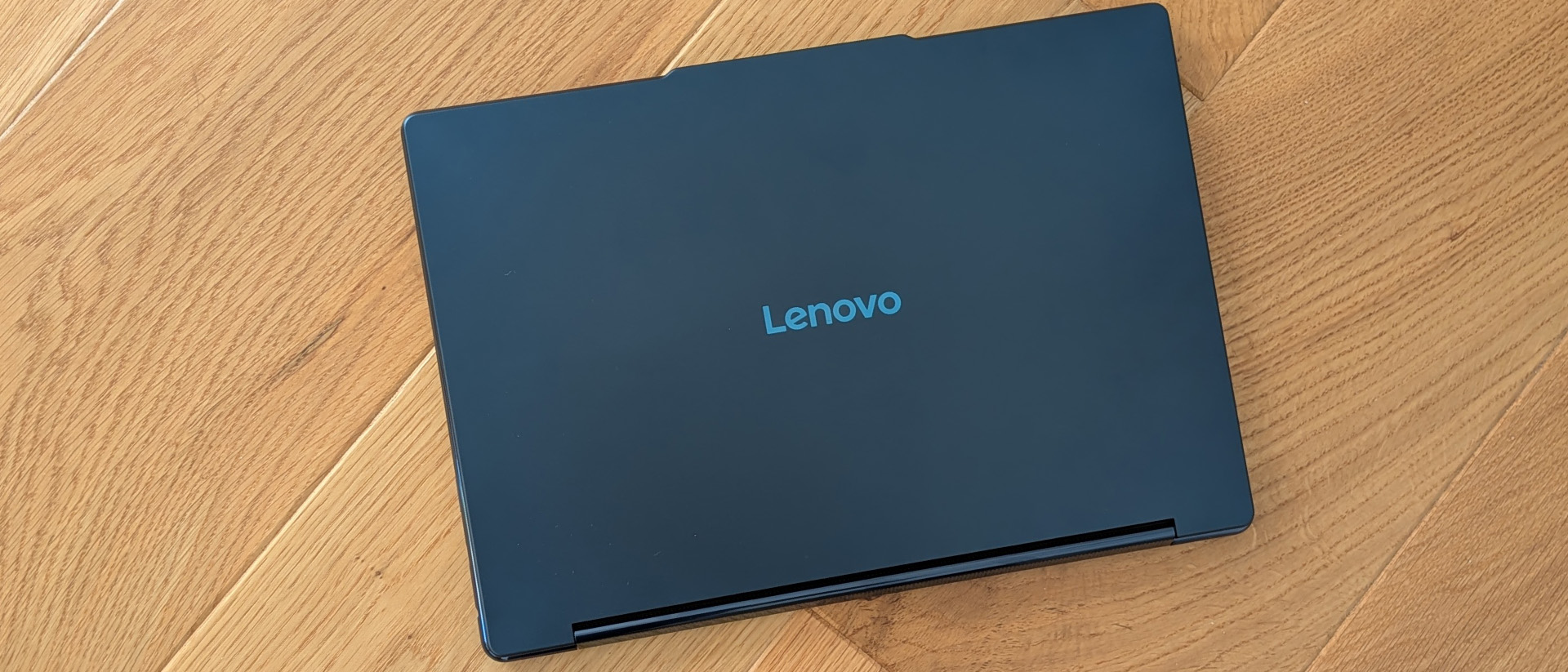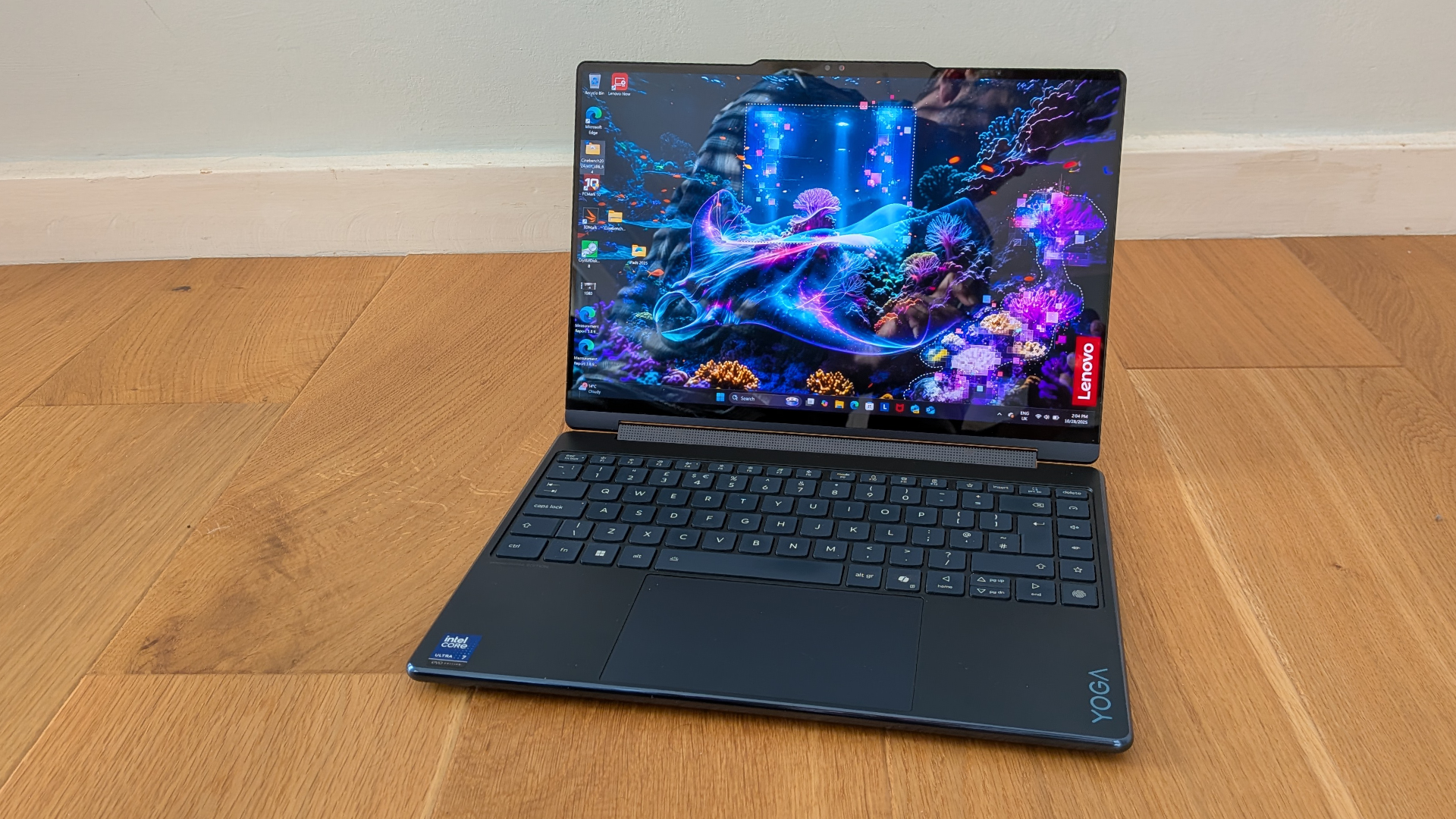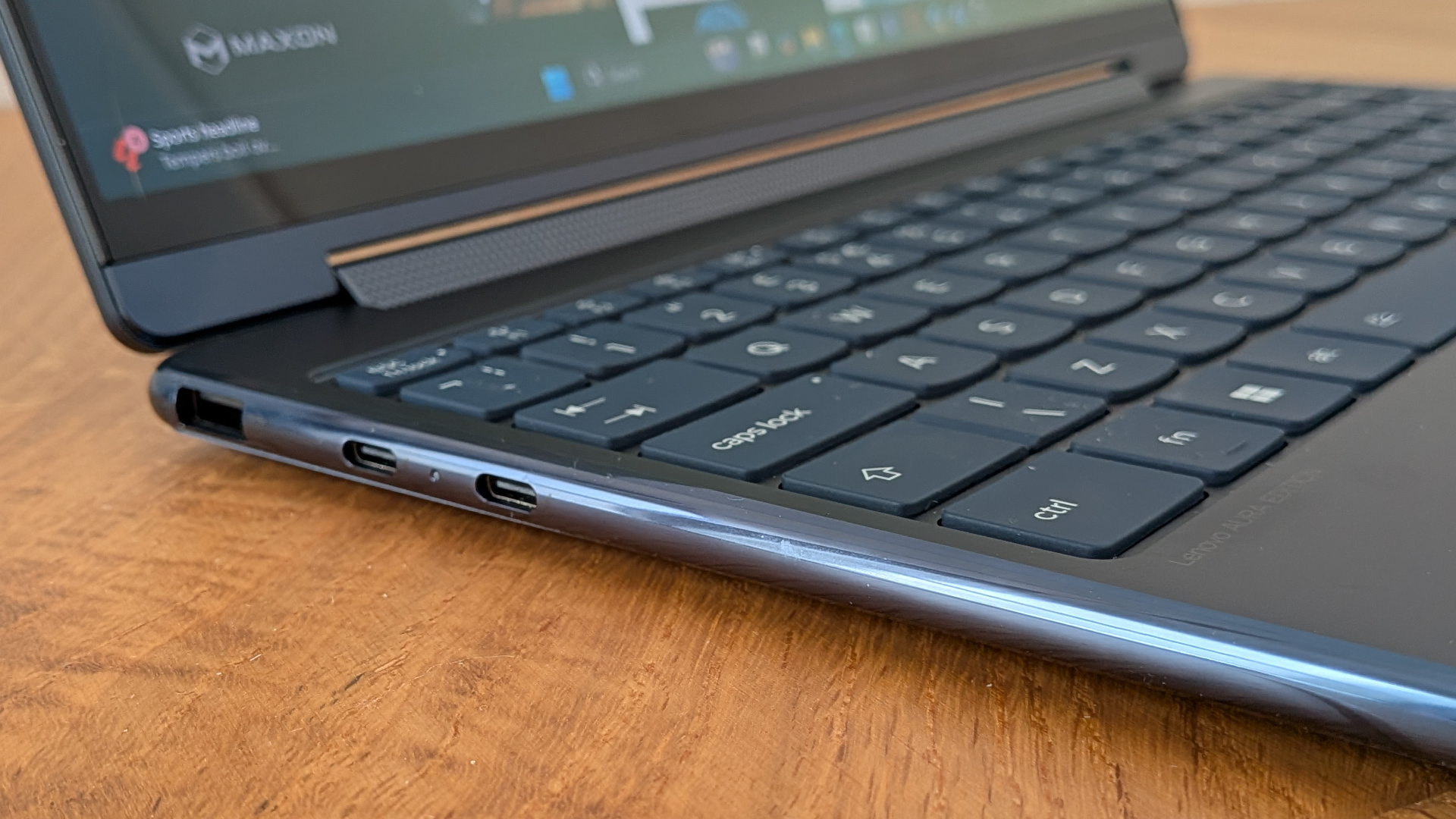Is the Lenovo Yoga 9i 2-in-1 Gen 10 Aura Edition the perfect laptop for creatives on the go?
A superb laptop for creative pros with awesome stamina and a fantastic screen

-
+
Dazzling wide color gamut OLED screen
-
+
Solid construction and flexible 2-in-1 design
-
+
Good balance of CPU, GPU and AI performance
-
+
Epic battery life
-
-
Webcam prone to shifts of brightness
-
-
Not the fastest in terms of multi-core grunt

Lenovo's latest Yoga is pitched as a premium convertible for mobile creatives; the sort of laptop you can lug around to show your work to clients or take out on the road when you need to design or edit away from your desk. As with previous Aura Edition models, it goes big on the quality of its display and its AI horsepower. In this case, we have a rather stunning 14in OLED screen plus an Intel Lunar Lake Core Ultra 7 CPU, giving you a combined 109 TOPs of AI processing to work with once you factor in the CPU, GPU, and NPU.
While Lenovo has a clear target market in mind for the Yoga 9i 2-in-1 Gen 10 Aura Edition, it's a tempting proposition for a wider audience of professionals. The screen is a beauty, the design is flexible and stylish, and the spec is competitive. We're not exactly short of decent options in this laptop class, but the Yoga 9i 2-in-1 Gen 10 Aura Edition is a serious contender.
Lenovo Yoga 9i 2-in-1 Gen 10 Aura Edition: Design

Compared to such slimmed-down laptops as the Asus Zenbook A14 or Acer Swift Edge 14 AI, the Yoga 9i 2-in-1 Gen 10 Aura Edition can feel a little hefty. Where those laptops are kept to less than 10mm thick, the Lenovo measures just under 16mm, while its 1.32Kg weight feels significantly heavier in the hands or in your bag.
What it has that those models lack, however, is a flexible 2-in-1 form factor. Push the screen back on its near-360-degree hinge, and it'll work in the classic tent or tablet modes, ideal for using with the bundled Yoga Pen stylus or sharing videos or presentations.
It's also a stylish unit, fashioned out of CNC-machined aluminum in a distinctive Cosmic Blue finish, with the only tangible seams found below decks, between the base plate of the unit and its mirror finish edges. It feels satisfyingly solid with barely any flex, even in the lid, and substantial in a good way. The shiny Lenovo and Yoga logos on the lid and keyboard deck are also a nice touch, even if the casing can be a fingerprint magnet.
Given the extra girth over the Acer and Asus laptops, it's slightly disappointing that physical connectivity is limited to three USB-C/Thunderbold 4 ports and a single USB 3.2 Gen 2 Type-A, but you could still run a DisplayPort monitor through one of the Thunderbolt 4 ports, and there's one on the right-hand side to give you options when you're charging. What's more, wireless connectivity is another story. With Wi-Fi 7 and Bluetooth 5.4 onboard, you can connect to the latest, fastest Wi-Fi networks and use more recent, low-latency wireless speakers or headsets, which may be critical where timing is important.
It's hard not to be impressed with the Yoga's premium keyboard. It doesn't look much different from those on other Yoga and IdeaPad devices I've looked at in the last year, but the feel is better, with a slightly firmer action, consistent actuation, and a speedy, highly tactile response. The layout has some oddities, particularly the column of function keys on the right, which shifts your hand position to the left. Still, it's nothing that you can't get used to in an hour or so of work. The touchpad is also excellent. Smooth and wide, it responds flawlessly to every swipe, tap, and pinching gesture.
Sign up today and you will receive a free copy of our Future Focus 2025 report - the leading guidance on AI, cybersecurity and other IT challenges as per 700+ senior executives
As we mentioned, Lenovo supplies the Yoga 9i 2-in-1 Gen 10 Aura Edition with a Yoga Pen stylus bundled in, which is a real bonus for sketching, taking notes, or annotating PDF documents. It's tilt-sensitive with up to 4,096 levels of pressure, and feels weighty and well-balanced in the hand. It will also stick magnetically to the rear edge or the bottom of the laptop when it's not in use, though you will want to take care that it doesn't get knocked off.
Lenovo Yoga 9i 2-in-1 Gen 10 Aura Edition: Display

It's possible to grow blase about laptop OLED panels, but not when the Yoga 9i 2-in-1 Gen 10 Aura Edition is around. It's not astoundingly bright with SDR content – we recorded maximum brightness levels of 400.1cdm2 – but contrast and definition are fantastic, and images burst with rich color and sharp detail on the 2880 x 1800 resolution screen.
Not only does the display cover 100% of the sRGB gamut, but 96.9% of Adobe RGB and 99.1% of DCI-P3. Needless to say, it's superb for bingeing video on Netflix, but with an average Delta E of only 0.86, it's more than capable of tackling color-critical image-editing or video work.
Sound from the Yoga is fantastic for a relatively thin and light device. Not only is it clear and spacious, but there's a warmth and depth you don't normally get from many mainstream laptops. It's perfect for video calls and meetings, but also good enough for background music while you work. The only trouble is that it goes loud enough without distorting that it's tempting to push the volume up to levels where your family or co-workers may complain.
The Yoga 9i 2-in-1 Gen 10 Aura Edition has a built-in 1440p webcam, complete with IR sensor for hassle-free Windows Hello sign-ins. It's better at full resolution than at 1080p, where the image loses detail and grows smudgy, but can be prone to constantly changing exposure as the light levels in the room change. Luckily, Windows Studio Effects can help maintain the balance, while giving you AI-enhanced auto-framing and portrait blur, plus the slightly uncanny eye contact effect.
Lenovo Yoga 9i 2-in-1 Gen 10 Aura Edition: Performance
The Yoga 9i 2-in-1 Gen 10 Aura Edition line uses Intel's Lunar Lake Core Ultra 7 processors, with our test model based on the Core Ultra 7 258V and fitted with a generous 32GB of RAM. Like the entire Lunar Lake line its based on four Performance cores and four Low Power Efficiency cores, with the only difference being the clock speeds, smart cache, and the spec of the built-in NPU and GPU. The 258V sits in the middle of the pack, with its P cores running at up to 4.8GHz, a 47 TOPS NPU, and an 8 Xe2 Core GPU running at up to 1.95Ghz.
With just eight cores to play with and no Simultaneous Multithreading (SMT) support, the Core Ultra 7 can't compete with the fastest Intel or AMD chips on intensive multi-core workloads. The Yoga scores 10889 in Geekbench 6's multi-core benchmark, where the Asus ProArt P16, with its AMD Ryzen 9 HX 370, scores 15192, and the Acer Aspire Vero 16, with its 16-core Arrow Lake Core Ultra 7 255H scored 14800. However, it's a fairer fight against slim-and-light models like the Acer Swift Edge 14 AI or the Asus Zenbook A14, with the Acer using the same CPU and the Asus an entry-level Snapdragon X Plus processor.
It's a similar story in the demanding Cinebench R24 3D rendering benchmark, where the Yoga scores 120 (single-core) and 574 (multi-core) to 121 and 479 from the Swift Edge 14 AI. The ProArt P16 is significantly faster in multi-core, with scores of 117 and 1156, but it's also a bigger, heavier, and more expensive device.

In general use, running productivity apps, the Yoga never feels anything less than snappy, and even running heavier workloads, working through high-resolution images in Affinity Photo, it was lightning fast. What's more, it's a good all-rounder. It has the NPU performance to handle emerging AI apps that might require one, plus the GPU performance for AI applications, like image generation, that perform better with a GPU in charge. Its scores in 3DMark – 4050 for the TimeSpy test and 3272 for the newer Steel Nomad (Lite) – even indicate solid 3D graphics performance. You won't be running modern AAA titles at a playable frame rate at the display's native 1800p, but stick to low detail levels and 1080p, and you should have more luck.
Credit to Lenovo, too, for not going cheap with the SSD. Not only does the 1TB drive hit sequential read speeds of 6960MB/sec, but sequential write speeds of 6878MB/sec, which is significanty higher than the average.
The big strength of the Lunar Lake architecture has been its energy efficiency, and it's here that the Yoga triumphs, coming slightly ahead of the Swift Edge 14 AI by lasting 19 hours and 8 minutes in our video rundown test. The only Windows laptops to do better have been based on Qualcomm's Snapdragon X CPUs, and while these offer slightly higher multi-threaded performance, this comes at the cost of an inferior GPU.
In real-world usage, we've found the Yoga can push effortlessly through a working day even with the screen brightness set high, and if you stick to adaptive brightness settings there will still be enough charge to take you well into the morning of the next day, too. There's precious little need to feel anchored to the mains.






Lenovo Yoga 9i 2-in-1 Gen 10 Aura Edition: Is it worth it?
Lenovo pitches this laptop at mobile creative pros, and it's a great choice for that market. There are faster options with bigger screens out there, like the ProArt P16, but they're neither as affordable nor as light. There's tougher competition from the Acer Swift Edge 14 AI, which is lighter, has a similar spec, and its own impressive OLED screen. Yet while the Acer has the advantage on weight and price, the Yoga is more versatile and wins on the keyboard and the overall feel.
It's not exactly cheap, but put together the specification, the stamina, the superb build quality, and that stunning screen, and it's hard to fault in terms of value. Better still, it's a treat to use.
Lenovo Yoga 9i 2-in-1 Gen 10 Aura Edition specifications
Display | 14-inch 2,880 x 1,800 OLED, 60Hz refresh rate | Row 0 - Cell 2 |
Processor | Intel Core Ultra 7 258V, 8-core, up to 4.8GHz | Row 1 - Cell 2 |
GPU | Intel Arc 140V | Row 2 - Cell 2 |
RAM | 32GB LPDDR5X | Row 3 - Cell 2 |
Ports | 3x Thunderbolt 4/USB-C, USB 3.2 Gen 2 Type-A | Row 4 - Cell 2 |
Camera | 5MP IR webcam | Row 5 - Cell 2 |
Storage | 1TB PCIe4 SSD | Row 6 - Cell 2 |
Connectivity | Wi-Fi 7, Bluetooth v5.4 | Row 7 - Cell 2 |
Weight | 990g | Row 8 - Cell 2 |
Dimensions | 316 x 220 x 15.9mm | Row 9 - Cell 2 |
Battery Capacity | 65Wh | Row 10 - Cell 2 |
Operating System | Windows 11 Home | Row 11 - Cell 2 |
Stuart has been writing about technology for over 25 years, focusing on PC hardware, enterprise technology, education tech, cloud services and video games. Along the way he’s worked extensively with Windows, MacOS, Linux, Android and Chrome OS devices, and tested everything from laptops to laser printers, graphics cards to gaming headsets.
He’s then written about all this stuff – and more – for outlets, including PC Pro, IT Pro, Expert Reviews and The Sunday Times. He’s also written and edited books on Windows, video games and Scratch programming for younger coders. When he’s not fiddling with tech or playing games, you’ll find him working in the garden, walking, reading or watching films.
You can follow Stuart on Twitter at @SATAndrews.
-
 Cisco says Chinese hackers are exploiting an unpatched AsyncOS zero-day flaw – here's what we know so far
Cisco says Chinese hackers are exploiting an unpatched AsyncOS zero-day flaw – here's what we know so farNews The zero-day vulnerability affects Cisco's Secure Email Gateway and Secure Email and Web Manager appliances – here's what we know so far.
By Emma Woollacott Published
-
 EU lawmakers want to limit the use of ‘algorithmic management’ systems at work
EU lawmakers want to limit the use of ‘algorithmic management’ systems at workNews All workplace decisions should have human oversight and be transparent, fair, and safe, MEPs insist
By Emma Woollacott Published
-
 Pure DC’s announces 'Europe’s largest standalone hyperscale data center lease' in Amsterdam — but who is the mystery customer?
Pure DC’s announces 'Europe’s largest standalone hyperscale data center lease' in Amsterdam — but who is the mystery customer?News The company is now constructing a 78MW campus in Westpoort, Amsterdam
By Emma Woollacott Published
